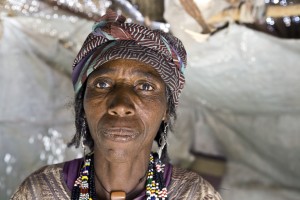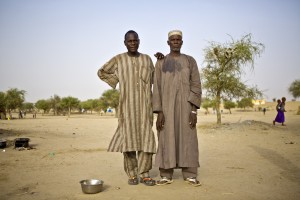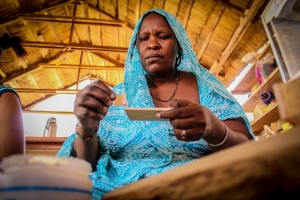Strengthening asylum policy and the fight against statelessness on the agenda of a high level meeting
The new asylum project is based on a strong tradition of hospitality and of protection for refugees in the country
Congratulations are exchanged between the Minister of the Interior, Public Security and Religious Affairs, Mr. Simplice Doussou Codjo, and UNHCR Regional Representative Mr. Mathijs Le Rutte, after signing an agreement on the Asylum Project in Benin and validating an action plan on the eradication of statelessness.
COTONOU, BENIN, 21 November 2014 (UNHCR) – Benin and UNHCR celebrated two milestones yesterday (Wednesday 20 November), with the signing of an agreement for the Asylum Project and the validation of a national action plan on the eradication of statelessness.
“Benin is not engaging in this Asylum Project because its asylum policy is poor,” explains Mathijs Le Rutte, UNHCR Regional Representative in Dakar, Senegal, who traveled to Cotonou for the occasion. “On the contrary, Benin has already worked towards having one of the best asylum systems in West Africa. It is in this spirit that today the Government of Benin continues to improve its asylum system by signing this agreement.”
The Asylum Project aims to strengthen the asylum system in Benin. It is based on a strong tradition of hospitality and of protection for refugees in the country and follows the successful implementation in January 2014 of durable solutions for protracted refugees. A partnership between the Government of Benin and UNHCR, as an impartial technical advisor, the Asylum Project enables the consolidation of the asylum system as a whole and optimizes the legislative reform steps taken to date, which will make the asylum law in Benin one of the most advanced and generous in the world.
In 2005, following political violence, more than 25,000 Togolese refugees found asylum in Benin. The majority soon returned to their country voluntarily. Amongst those who remained, a group of more than 3,000 recently benefited from a privileged residence card.
Benin currently hosts some 465 refugees on its territory, mainly from Ivory Coast and the Central African Republic, who fled crisis situations in their countries, in 2010-2012 and 2013-2014 respectively. They remain in urban areas, mainly in the capital.
On the statelessness side, since December 2011, Benin has been a party to the 1954 Convention relating to the status of statelessness as well as the 1961 Convention on the reduction of statelessness. A country team composed of the Government, UNHCR, civil society, media and open to other relevant stakeholders has developed a roadmap in order to identify situations involving a risk of statelessness, to raise awareness amongst the general population as well as key actors, and to improve the legal and administrative frameworks related to nationality. The team conducts field studies in areas where it has been identified that the population is at risk of statelessness. For example, some 2,000 people are reportedly stateless or at risk of statelessness on Ile aux Oiseaux, a small island transferred from Niger to Benin in 2005.
The action plan that has now been validated is part of the global campaign to eradicate statelessness which was launched by UNHCR in November 2014. It reflects the political commitment of the Government of Benin to eradicating the phenomenon of statelessness on its soil. The plan sets out a series of actions to definitively end the plight of statelessness people and is the product of consultations involving all humanitarian and political actors fighting the phenomenon of statelessness in Benin.
For more information on Ile aux Oiseaux:
http://kora.unhcr.org/citizens-nowhere-plight-stateless-persons-ile-aux-oiseaux/
Le texte en français:Renforcement de la politique d’asile et lutte conte l’apatridie au programme d’une réunion de haut niveau au Bénin.
Le Projet Asile est fondé sur la forte tradition d’accueil et de protection des réfugiés dans le pays
COTONOU, BENIN, 21 novembre 2014 (HCR) - Le Bénin a célébré deux événements majeurs hier (mercredi 20 novembre), avec la signature d’un accord sur le projet Asile et la validation du plan d’action national d’éradication de l’apatridie.
« Ce n’est pas parce que la politique d’asile est mauvaise que le Bénin s’engage dans ce projet Asile » précise Mathijs Le Rutte, Représentant Régional du HCR basé à Dakar, au Sénégal, et qui a fait le déplacement sur Cotonou pour l’occasion. « Au contraire, le Bénin avait déjà l’un des meilleurs systèmes d’asile en Afrique de l’Ouest. C’est dans cet esprit qu’aujourd’hui le gouvernement continue d’améliorer son sytème d’asile en signant cet accord».
Le Projet Asile vise donc à consolider le système d’asile au Bénin. Il est fondé sur la forte tradition d’accueil et de protection des réfugiés dans le pays et suit la mise en œuvre à succès des solutions durables en faveur des réfugiés de longue durée achevée en janvier 2014. Partenariat entre le gouvernement béninois et le HCR, en tant que conseiller technique impartial, le projet Asile permet la consolidation de l’ensemble du dispositif asilaire béninois ainsi que l’optimisation des démarches faites vers une réforme législative qui ferait de la loi béninoise en matière d’asile une des plus avancées et généreuses au monde.
En 2005, suite aux violences politiques, plus de 25 000 réfugiés togolais avaient trouvé asile au Bénin. La plupart étaient rapidement rentrés dans leur pays volontairement. Parmi ceux qui sont restés, un groupe de plus de 3000 personnes ont aussi récemment pu bénéficier de la carte de résidence privilégiée.
Le Bénin accueille actuellement quelque 465 réfugiés sur son territoire, essentiellement originaires de la Côte d’ivoire et de Centrafrique, qui ont fui des situations de crises dans leurs pays, respectivement en 2010-2012 et en 2013-2014. Ils demeurent en milieu urbain, principalement dans la capitale.
Du côté de l’apatridie, depuis décembre 2011, le Bénin est parti à la Convention de 1954 relative au statut d’apatride ainsi qu’à la Convention de 1961 sur la réduction des cas d’apatridie. Une équipe pays composée du Gouvernement, du HCR, de la société civile, des médias, et ouverte à d’autres acteurs pertinents a élaboré une feuille de route afin d’identifier des situations de risque d’apatridie, de sensibiliser la population et des acteurs clés, ainsi que d’améliorer les cadres juridique et administratif liés à la nationalité. Cette équipe mène des études de terrain dans les régions où des populations à risque d’apatridie ont été identifiées. Il y aurait par exemple quelque 2,000 personnes apatrides ou à risque d’apatridie sur l’Ile aux Oiseaux, une petite île transferée du Niger au Bénin en 2005.
Le plan d’action qui vient d’être validé s’inscrit dans le cadre de la campagne mondiale d’éradication de l’apatridie lancée par le HCR en Novembre 2014. Il traduit l’engagement politique du gouvernement béninois à éradiquer sur son sol le phénomène de l’apatridie. Ce plan énonce une série d’actions visant à lutter définitivement contre le fléau et est le fruit de consultations impliquant l’ensemble des acteurs humanitaires et politiques qui luttent contre le phénomène de l’apatridie au Bénin.
Pépin Glele
Pour plus d’information sur l’Ile aux Oiseaux :
http://kora.unhcr.org/citizens-nowhere-plight-stateless-persons-ile-aux-oiseaux/




















